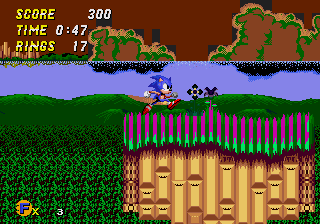Sonic Timezones
From Sonic Retro
| Sonic Timezones |
|---|
| Version: 0.01a Beta |
| Last release: 2002-11-02 |
| Status: Inactive |
| System: Sega Mega Drive |
| Original game: Sonic the Hedgehog 2 (16-bit) |
| Credits: Saxman |
Sonic Timezones is a hack of Sonic the Hedgehog 2 by Saxman. It was unique at the time of its release due to new code being added to add new features, such as time travel, a primitive super peel-out move, and SRAM support. All of the instructions were written by hand using a hex editor since there wasn't a disassembly of the game at the time. It was also the first hack to replace compressed art, as well as the first to use new music. It was entered into the 2002 Sonic Hacking Contest on May 19, 2002 and went on to win the Tech Trophy. The final release was made on November 2, 2002.
Contents
Tech Highlights
Time Travel
The main focus of the hack involves time travel. The layouts of Emerald Hill Zone act 1 and Oil Ocean Zone act 1 have both been altered slightly to make it easy for the player to obtain 50 rings at the beginning of those stages, after which a time warp can be achieved by jumping through the revolving stars above a star post (which lacks graphics).
Sonic's Moves
The spindash was altered to charge at full speed with a single button press in an effort to mimic how it works in Sonic CD. Additionally, a (buggy) super peel-out was added.
Graphics
The HUD graphics were replaced, marking the first time any graphics using Nemesis compression were changed. The Nemesis compression format had not yet been cracked at the time, so new code was written to bypass the use of Nemesis and instead read raw pixel data. The code was written with condition checks to load alternate life icons depending on the time zone. All icons come from Sonic CD.
The code used to perform these graphical swaps was shared with other Sonic ROM hackers to add the capability to their hacks. Among the hacks that used it were More Than a Memory: A Perfect Existence and Project Shadow 2.
Soon after Sonic Timezones 0.01 Beta was released, Saxman began working on the RXL patch format to add new code to a ROM with dynamic addressing in mind. The second RXL patch Saxman created allowed the life icon to be altered using the same methodology used in Sonic Timezones.
Following the creation of additional RXL patches to replace the intro and title screen graphics each, a minor update to Sonic Timezones was built on November 2, 2002 that replaced those screens. The title screen replacement graphics were intended to be temporary until a proper title screen could be designed, although no additional work was ever done to it.
Sound and Music
Sonic Timezones also uses the sound driver from the Simon Wai prototype and was the first hack to feature new music. All music sequences were done by hand using a hex editor since there were no music editing tools available at the time. The following song numbers were replaced:
- 01 - The Heart of Rock & Roll (Huey Lewis and the News)
- 02 - Green Hill Zone
- 12 - Yakety Sax (Boots Randolph)
Additionally, the SEGA choir sound was also replaced and recorded by Saxman with the help of the Sonic Sound Editor.
SRAM Support
Sonic Timezones was the first hack to add support for SRAM to allow game progress to be saved in a similar manner as Sonic 3. A game can be continued using the '2 Player Vs' option on the title screen. Save slots can be changed from the options screen. It was tested using Gens and isn't guaranteed to work on other emulators.
Downloads
| Download Sonic Timezones
File: Timezones_v0.01a-Beta.zip (710 kB) (info)
Current version: 0.01a Beta |
Prior Versions
Timezones Builds
- Sonic Timezones v0.01 Beta (2002-05-19) (info) (54 kB)
- Sonic Timezones (2002-05-15) (info) (35 kB)
- Sonic Timezones (2002-05-11) (info) (24 kB)
- Sonic Timezones (2002-05-01) (info) (47 kB)
- Sonic Timezones (2002-04-07) (info) (2 kB)
- Sonic Timezones (2002-04-04) (info) (719 kB)
Experimental Builds
- Experimental (2002-04-03) (info) (720 kB)
Sax Tech Builds
- Sax Tech (2002-03-22) (info) (760 kB)
- Sax Tech (2002-01-27) (info) (63 kB)
- Sax Tech (2002-01-20) (info) (63 kB)
- Sax Tech (2002-01-19 20:14) (info) (718 kB)
- Sax Tech (2002-01-19 15:42) (info) (718 kB)
- Sax Tech (2002-01-18) (info) (698 bytes)
Notes
- Code/data offset notes (2002-11-02) (info) (736 bytes)
- Logic notes (2002-05-11) (info) (600 bytes)
- Code/data offset notes (2002-04-04) (info) (557 bytes)
